THE ORIGINS OF ICAO AVIATION TRAINING INTELLIGENCE
In the early 1970s the International Telecommunication Union (ITU) began pioneering TRAINTEL (Telecommunications) training programme to develop their training courses. Building on their experiences, with the intent to globally implement competency-based training methodology, the United Nations Organization (UNO) launched the Train-X Programme in the 1980s.
Train-X was very effective in terms of improving and modernizing the training carried out by the cooperative training networks of several UN agencies, including, among others, TRAINMAR and TRAINTRADE for the United Nations Conference on Trade and Development (UNCTAD) and CODETEL for ITU. Since 1992 four additional UN agencies joined the UN TRAIN-X Network: the United Nations established TRAIN-SEA-COAST; the United Nations Institute for Training and Research (UNITAR) established CC:TRAIN for Climate Change; the Universal Postal Union (UPU) established TRAINPOST for postal services; and the Food and Agriculture Organization (FAO) established TRAINFISH for fisheries.
The TRAINAIR Programme was created in the early 1990s to enable ICAO to cover training in all fields of civil aviation through global implementation of the Standardized Training Package (STP) concept, detailed in the Training and Development Guide (TDG), ICAO DOC 9941. In 2012, the TRAINAIR Programme evolved into the TRAINAIR PLUS Programme (TPP) which expanded to include the bigger aviation training community, international institutions and universities.
The TPP enhanced the competency-based methodology which is currently implemented in close to 80 States and used by more than 100 training centres and educational institutions. The TPP comprises a virtual library with close to 160 courses, including learning packages that generate career paths combining professional certification and academic degrees.
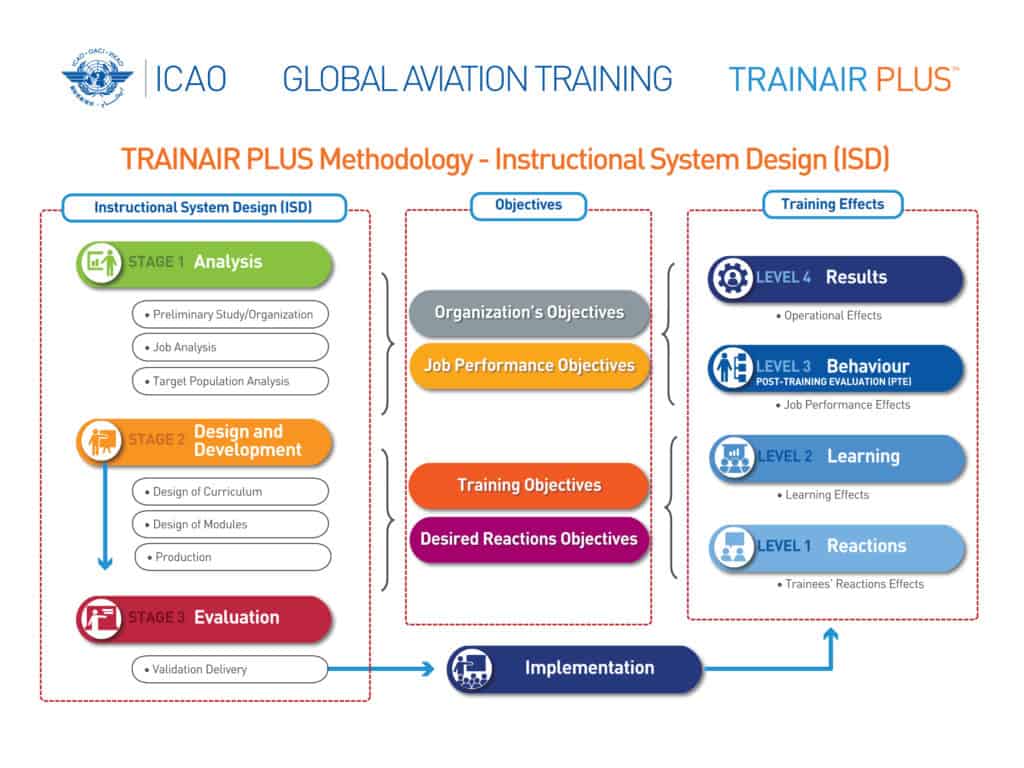
Training activities conducted within the realm of TPP, ICAO technical cooperation projects, and aviation safety and security training provided by ICAO Bureaux and Regional Offices, laid the ground for the creation of the ICAO Civil Aviation Training Policy. In 2014, the Global Aviation Training (GAT) Office was established to harmonize standardization and management of training activities.
TRAINING CHALLENGES
In standardizing global training, several recurring challenges have been encountered. These include insufficient funding; lack of subject matter expertise and qualified instructors; poor specialized equipment; non-recognition of certificates between States (even in the same regions); and a lack of harmonization of curricula and licensing requirements.
Scenarios like these make it difficult to implement the ICAO Civil Aviation Training Policy. The policy provides for a global training standardization model which facilitates the effective and harmonized implementation of training in aviation, reduces costs, increases quality and efficiency and generate synergies between two important ICAO initiatives: the Next Generation of Aviation Professionals (NGAP) and No Country Left Behind (NCLB).
DATA-DRIVEN DECISIONS
These challenges are predicated on the absence of suitable and effective links between aviation data and aviation training planning and implementation. Making data-driven decisions is already applied in several aviation fields, such as safety management, passenger distribution, and aviation cargo, as examples. Data-driven decision making or D3M, is a process-driven approach to decision making that addresses issues leading to poor decision making. With D3M, effective and informed decisions are based on the results of pertinent data that has been collected and analysed.
Using valid and relevant data helps place the “problem” in the right context to determine a best-fit “solution”. D3M provides credible evidence to stakeholders and management regarding strengths, weaknesses, opportunities, limitations and risks. It mitigates bias, influence and human error. Applying D3M in conjunction with organizational analyses, and training needs and impact assessment activities, becomes an important element of support to States facing challenges in aviation training.
As with any mathematical model, the more information that can be integrated in the model, the more useful it becomes for strategic and operational planning purposes, given that it reflects facts and figures from the field. Applying D3M to aviation training planning will lead to the development of targeted training portfolios that respond to identified human resource needs in aviation. Business cases can be developed to acquire the expertise, equipment or facilities necessary to operationalize the portfolio.

AVIATION TRAINING INTELLIGENCE™
To effectively apply D3M a management system and methodology needs to be adopted. Existing volumes of diverse information, and vast amounts of aviation data need to be managed. At ICAO, data tools such as iImplement, iSTARS, the Safety Solution Center, CAA HR-toolkit, Environment data, Economic Development and Aviation Business Analysis tools, Data+, traffic forecasting, statistics analysis, are transformed through a technology-driven process into an aviation training data management environment.
Applying the data-driven business process using the principle of analysing aviation and training data to provide actionable information for training decisions, provides executives, managers and other corporate end users with Aviation Training Intelligence™ (ATI™). This intelligence is used to make informed business decisions.
Training organizations that invest in technology tools and methodologies to collect, analyse and manage their ATI™ will grow in alignment with aviation growth and training methodologies that are rapidly evolving.
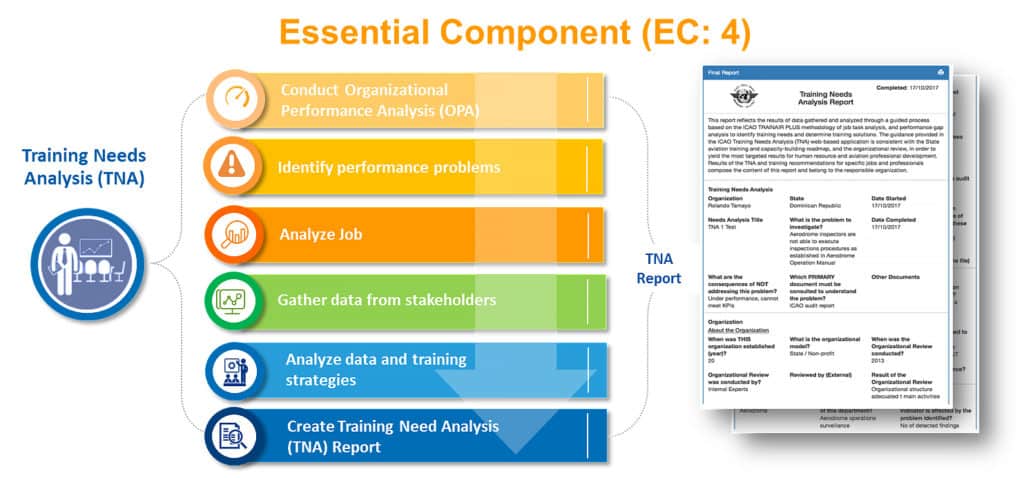
MANAGING AVIATION TRAINING INTELLIGENCE™ (MATI™)
Managing aviation training intelligence is the real challenge of aviation training organizations today. Activities involve continuous improvement planning; implementation of technology systems to manage aviation big data; State aviation forecasts; predictive analytics; needs assessment data; trainee, impact and collaborative data; as well as data generated from new learning technologies such as machine learning, artificial intelligence, augmented reality, gamification and more. Managing ATI™ is the practice of mapping methods, tools, systems, applications, needs and solutions for individuals and groups.
AVIATION TRAINING INTELLIGENCE™ CONSISTS OF EIGHT ESSENTIAL COMPONENTS (EC):
The essential components shown below are integrated on logical flows, sequences and feedback mechanisms, providing the data sources leading to data-driven decision making.

INTEGRATED TRAINING MANAGEMENT SYSTEM (ITMS) AND MATI™ TOOLS
ATI™ must be collected, structured, processed, analysed, integrated and evaluated. An integrated information structure is required for conducting up-to-date and needs-based aviation training activities. For ICAO, the automation of training and capacity-building processes is key to providing States, TPP Members, and the aviation community, efficient and cost-beneficial support and solutions for their training needs and endeavours. Strategic and operational planning, business implementation, course development and delivery, are managed according to diverse data using a set of tools and methodologies, to make optimal aviation training decisions.
ICAO’s Aviation Training Intelligence™ management system will integrate TRAINAIR PLUS systems such as the TPeMS (TRAINAIR PLUS Electronic Management System); a web-based Training Needs Assessment tool, Training Evaluation Portal, Instructional System Design (ISD) tool, Aviation Training and Education Directory (AETD), Subject Master Expert roster, and a Learning Management System (LMS) in a new, integrated network system architecture.
The integrated management system stores, structures and automates training transactions and decisions actioned by a variety of global users including trainees, managers, course developers, instructors, validators, and administrators.
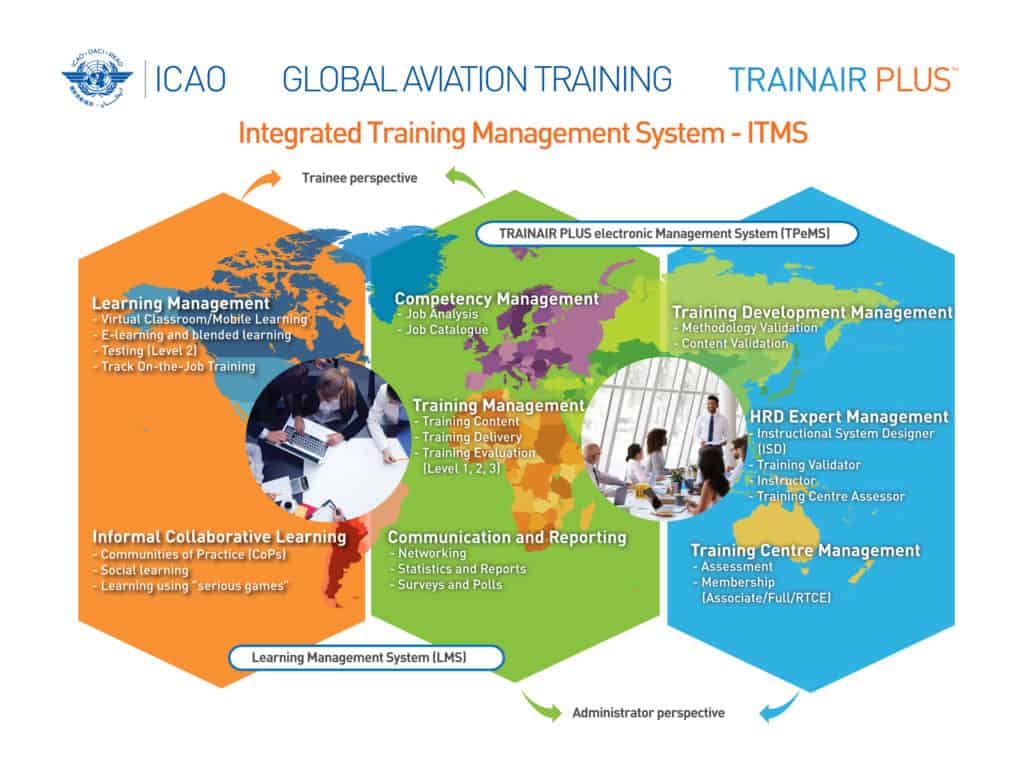
MATI™ FOR TRAINING EFFECTIVENESS
Excellent learning progression during a training course with positive feedback from trainees and instructors, appropriate facilities and equipment, can be a useless exercise and even worse, a waste of time and money, if there is no transfer of the acquired competencies to the workplace. The capability to measure the impact of training on professional performance is critical for personal and professional development, and organizational achievement.
Evaluation of the training effectiveness of each course using the ICAO TRAINAIR PLUS Post- training Evaluation (PTE) methodology follows a scientific basis for measuring the impact of training programmes developed under the guidelines set out in the TDG/Doc 9941. Given the inherent nature of the methodology and its competency-based approach, MATI™ integrates an evaluation procedure aimed to enhance the quality of training developed, the instructional processes used, and provides intelligence on the impact of the training as part of the continuous improvement of the TRAINAIR PLUS Programme.
The MATI™ PTE Weighted Impact Index™ (WIN™) equation is calculated by analysing the data collected after course deliveries (post three to six months), using the L3 PTE tool which is a standardized scale with 15 impact indicators related to six dimensions of evaluation. The result obtained is a quantitative value of the real effectiveness representing the impact of the training on work performance.
The complete implementation of the ICAO training portfolio will be evaluated and reported based on the WIN rate from each course. It will be the mechanism used for continuously revising curricula to calibrate and correct technical, practical and useful content, and the instructional interactivity of the training.
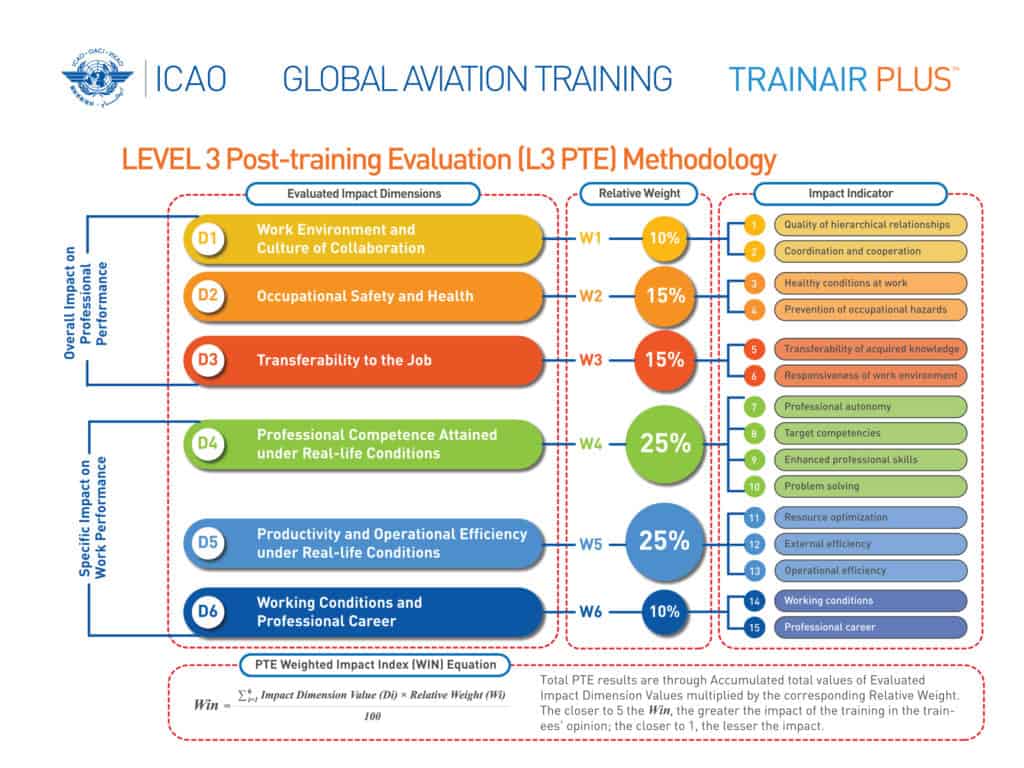
MATI™ INTEGRATED PROCESSES AND IMPLEMENTATION
Managing your ATI™ necessitates engagement in diverse business practices and processes that generate data and information that will be used for decision making to optimize the training portfolio of your organization. The integration of each essential component is supported by an integrated system architecture with the compatibility and interoperability of projects, workflows, social media management, collaborative management with business networks and communities of practice, business processes, communication and connectivity.
MATI™ Essential Components (EC) are linked through the safety and air transport data collected (EC1, EC2), that are transformed into aviation training data (EC3) and used for training need analysis (EC4), identifying existing training solutions (EC5) or developing the missing courses (EC6), giving evaluation of its effectiveness (EC7) in the alignment with the State’s Aviation Master Plan and Human Resources and Capacity Improvement (HR/CI) planning and development (EC8). MATI™ integrates a structured plan of actions to implement comprehensive and consistent human resources development strategies to meet the State’s strategic objectives, development goals, and the needs of the aviation sector.
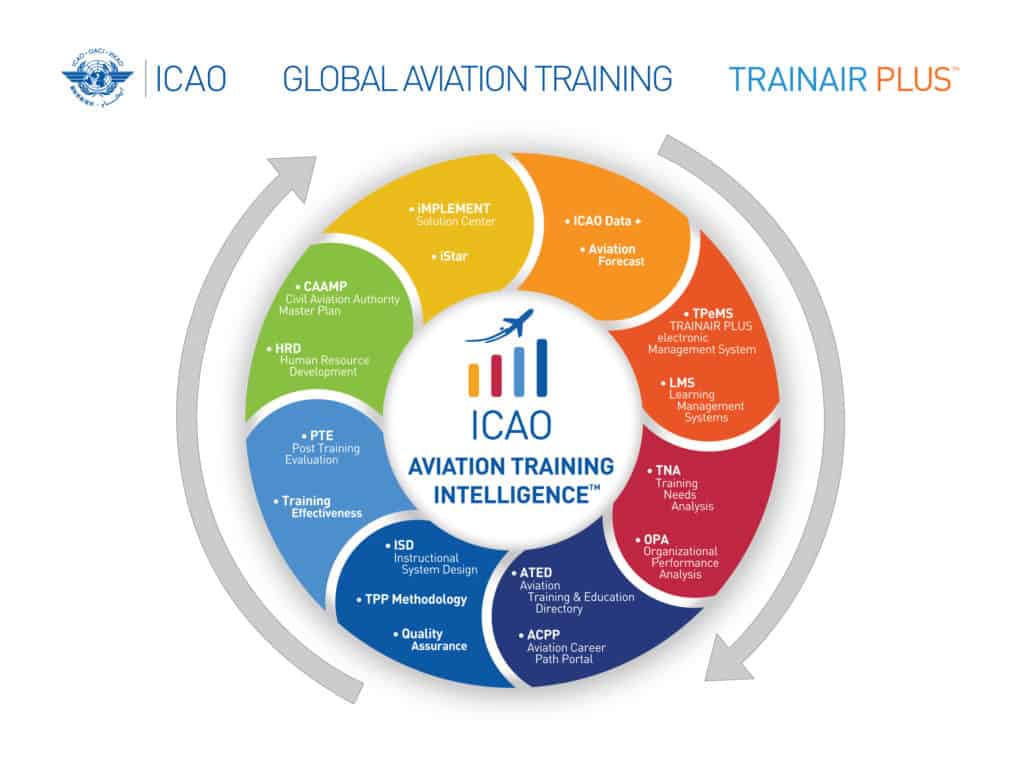
BUSINESS EFFICIENCY MODELS
Aviation Data-driven Decision Making (AD3M) and Managing Aviation Training Intelligence™ (MATI™) are the new models for business efficiencies in a complex aviation training world. The ability to provide quality, standardized, competency-based training through a variety of media, that meets current and future needs of multiple stakeholders, requires multiple sources of data and information to be systematically collected, integrated and analysed by aviation training managers.
A deep dive into Aviation Training Intelligence™ reveals that its global implementation will strongly support the generation of strategic partnerships among government, education, academia, and industry, as well as a strong alliances among enthusiastic students, competent instructional teams, and committed training managers, to attract and transform each trainee into new, competent aviation talent for personal, professional, and organizational success.
These models will help training managers to continue to modernize their operations, better address the training challenges, and meet both the actual needs of the aviation sector, and the demands from industry. Managing Aviation Training Intelligence™ enables people and organizations to join the scenario where effective training goes beyond training solutions for performance, to improving safe, secure and efficient air transport connectivity as a key element to social, environmental and economic growth, supporting UN Sustainable Development Goals and 2030 Agenda.
About the Authors
Diego Martinez is the Manager of the TRAINAIR PLUS Programme for ICAO Global Aviation Training (GAT).
Bonnie McEachern is the Instructional Systems Design Specialist for ICAO Global Aviation Training (GAT).

